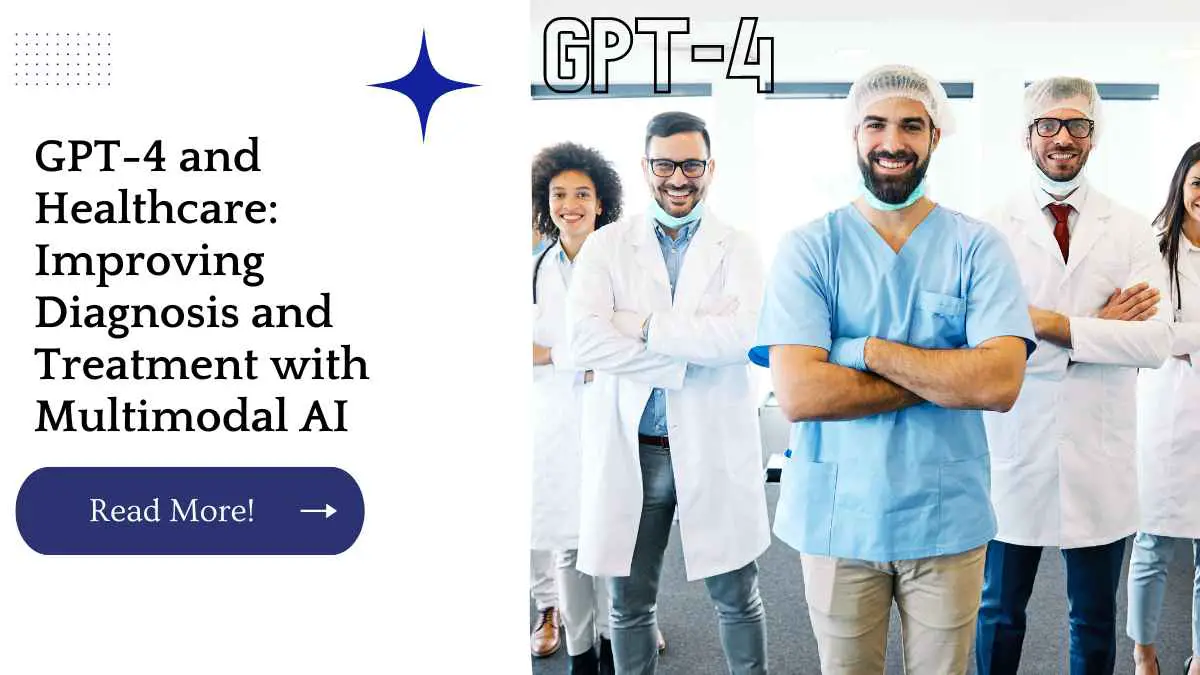Artificial intelligence (AI) is transforming healthcare, improving patient outcomes and increasing efficiency. GPT-4, a multimodal model from Microsoft-OpenAI, has the potential to revolutionize the healthcare industry further.
Its ability to integrate text, images, video, and sound can provide clinicians with a comprehensive understanding of patient health, leading to more accurate diagnoses and personalized treatment plans. In this blog post, we’ll explore how GPT-4 can improve healthcare, highlighting ten potential use cases.
| Takeaways |
|---|
| GPT-4 is a new AI language model developed by OpenAI that is capable of processing multimodal inputs, such as images and audio, in addition to text. |
| GPT-4 has the potential to revolutionize industries such as healthcare, e-commerce, media and entertainment, and more through its advanced capabilities. |
| Microsoft highlights the potential for AI to improve healthcare in areas such as disease detection and prevention, drug discovery, and personalized medicine. |
| The release of GPT-4 in March 2023 is highly anticipated and could mark a significant advancement in the field of natural language processing. |
| Nature provides an informative overview of GPT-4 and its potential impact on the future of AI language models. |
Multimodal Diagnosis: Improving Accuracy with Multiple Data Sources
GPT-4 can integrate multiple data sources, such as electronic health records (EHRs), medical imaging, and patient-generated data, providing clinicians with a more comprehensive view of patient health. This can lead to more accurate diagnoses and personalized treatment plans, improving patient outcomes. For instance, GPT-4 can help identify high-risk patients who require closer monitoring or early intervention.
Moreover, the multimodal diagnosis can enhance the accuracy of radiology by combining text, image, and video data. GPT-4 can analyze medical images and provide automated interpretation, improving accuracy and reducing the workload for radiologists. Also, the model can detect relevant patterns in medical data, reducing diagnostic errors and improving patient outcomes.
GPT-4 is expected to revolutionize the field of language generation and pave the way for exciting new applications. To learn more about the next leap in AI, check out our article on GPT-4’s arrival.
Drug Discovery: Streamlining the Process with AI
The drug discovery process is lengthy and expensive, but AI can help streamline it. GPT-4 can analyze large volumes of data, including scientific literature and clinical trial data, to identify potential drug targets and improve drug development. For instance, the model can predict the efficacy of drug candidates and potential side effects, allowing researchers to focus their efforts on the most promising candidates.
Precision Medicine: Personalizing Treatment Plans with AI
Precision medicine aims to tailor treatment plans to individual patients, taking into account their genetic makeup, medical history, and lifestyle factors. GPT-4 can integrate this information to provide personalized treatment recommendations, improving patient outcomes and reducing the risk of adverse events. For instance, the model can suggest the most effective treatments for a patient based on their genomic data and medical history.
Multimodal AI has the potential to enhance productivity and streamline complex workflows. For more information on how GPT-4 is being used to improve productivity, take a look at our article on reinventing productivity with AI.
Medical Imaging: Enhancing Accuracy with AI
Medical imaging, such as X-rays and MRIs, can provide valuable diagnostic information, but interpretation can be challenging. GPT-4 can analyze medical images and provide automated interpretation, improving accuracy and reducing the workload for radiologists. The model can identify subtle changes in medical images that might not be visible to the naked eye, allowing for early detection of diseases like cancer and other chronic conditions.
Telemedicine: Improving Access to Healthcare with AI
Telemedicine is becoming increasingly popular, but language barriers can be a challenge. GPT-4’s multilingual capabilities can improve communication between patients and healthcare providers, improving access to healthcare and reducing disparities in care. The model can provide translation services in real-time, allowing clinicians to communicate with patients who speak different languages.
Clinical Trials: Optimizing Recruitment and Retention with AI
Recruiting and retaining participants in clinical trials can be challenging, but AI can help. GPT-4 can analyze patient data and identify individuals who are most likely to participate and complete the trial, improving efficiency and reducing costs. Moreover, the model can predict the likelihood of success for a particular clinical trial, allowing researchers to allocate resources more efficiently.
Medical Education: Enhancing Learning with AI
AI can improve medical education, providing students with access to vast amounts of information and personalized learning experiences. GPT-4 can provide automated feedback and assessment, improving learning outcomes and reducing the workload for educators. Moreover, the model can identify knowledge gaps and provide personalized learning plans for students.
Data analysis is crucial for decision-making in healthcare, and GPT-4’s multimodal capabilities are poised to enhance this process. Learn more about the use of GPT-4 in environmental sustainability and data analysis in our article on enhancing data analysis with multimodal AI.
Electronic Health Records: Improving Efficiency with AI
Electronic health records (EHRs) can be challenging to navigate, but AI can help. GPT-4 can analyze
EHRs and extract relevant information, reducing the workload for clinicians and improving efficiency. The model can also identify potential errors or inconsistencies in EHRs, improving data quality and patient safety.
Patient Monitoring: Improving Outcomes with AI
GPT-4 can analyze patient data in real-time, providing clinicians with timely alerts and insights that can improve patient outcomes. The model can identify high-risk patients who require closer monitoring, reducing the risk of adverse events. Additionally, the model can track patient progress over time and suggest adjustments to treatment plans as necessary, ensuring that patients receive the most effective care.
GPT-4’s multilingual and multimodal models hold great promise for education, especially in the realm of language learning. To read more about how GPT-4 is being used to enhance education, check out our article on enhancing learning with GPT-4
Medical Research: Accelerating Discoveries with AI
AI can help accelerate medical research, providing researchers with access to vast amounts of data and insights. GPT-4 can analyze scientific literature, clinical trial data, and other sources of information, identifying trends and patterns that can inform new research. Moreover, the model can generate hypotheses and suggest new areas of investigation, accelerating the discovery of new treatments and cures.
GPT-4’s multimodal capabilities have the potential to break down barriers in media and entertainment, creating exciting new possibilities for creative expression. To learn more about GPT-4’s role in media and entertainment, take a look at our article on breaking barriers with GPT-4’s multimodal capabilities.
Conclusion:
GPT-4 has the potential to transform healthcare, improving patient outcomes and increasing efficiency. The model’s ability to integrate multiple data sources, analyze vast amounts of information, and provide personalized recommendations can help clinicians provide more accurate diagnoses and personalized treatment plans.
Additionally, the model can improve drug discovery, medical imaging, telemedicine, clinical trials, medical education, EHRs, patient monitoring, and medical research. As the healthcare industry continues to adopt AI, GPT-4 will likely play a critical role in improving patient outcomes and advancing medical research.
Further Reading
OpenAI Launches Its New Multimodal AI, GPT-4 – Learn more about the release of GPT-4 and its potential applications in this article from Mobile Magazine.
AI and the Future of Health – Microsoft discusses the role of AI in healthcare and the potential for AI to revolutionize the industry in this blog post.
GPT-4: the next revolution in natural language processing, coming in March 2023 – Nature provides an overview of GPT-4 and its potential impact on the field of natural language processing.
FAQs
What is GPT-4?
GPT-4 is a new AI language model developed by OpenAI that is capable of processing multimodal inputs, such as images and audio, in addition to text.
What are the potential applications of GPT-4?
GPT-4’s multimodal capabilities could have numerous applications, including improving productivity, enhancing data analysis and decision-making, personalizing shopping experiences, and improving healthcare diagnosis and treatment.
When will GPT-4 be released?
According to a recent Nature article, GPT-4 is expected to be released in March 2023.
How does AI improve healthcare?
AI can improve healthcare in numerous ways, including by enabling faster and more accurate diagnoses, identifying patients at risk for certain conditions, and personalizing treatment plans.
What is the role of AI in the future of healthcare?
AI is expected to play an increasingly important role in healthcare in the coming years, with potential applications in areas such as disease detection and prevention, drug discovery, and personalized medicine.

Costantine Edward is a digital marketing expert, freelance writer, and entrepreneur who helps people attain financial freedom. I’ve been working in marketing since I was 18 years old and have managed to build a successful career doing what I love.
